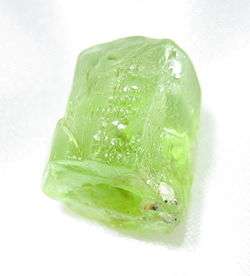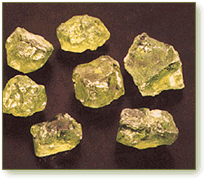Peridot
| Peridot | |
|---|---|
 | |
| General | |
| Category | Silicate mineral variety |
| Formula (repeating unit) | (Mg, Fe)2SiO4 |
| Crystal system | Orthorhombic |
| Identification | |
| Color | Yellow, to yellow-green, olive-green, to brownish, sometimes a lime-green, to emerald-ish hue |
| Cleavage | Poor |
| Fracture | Conchoidal |
| Mohs scale hardness | 6.5–7 |
| Luster | Vitreous (glassy) |
| Streak | None |
| Specific gravity | 3.2–4.3 |
| Refractive index | 1.64–1.70 |
| Birefringence | +0.036 |
Peridot (/ˈpɛrᵻdɒt/ or /ˈpɛrᵻdoʊ/) is gem-quality olivine, which is a silicate mineral with the formula of (Mg, Fe)2SiO4. As peridot is the magnesium-rich variety of olivine (forsterite), the formula approaches Mg2SiO4.
Etymology
The origin of the name peridot is uncertain. The Oxford English Dictionary suggests an alteration of Anglo–Norman pedoretés (classical Latin pæderot-), a kind of opal, rather than the Arabic word faridat, meaning "gem".
The Middle English Dictionary's entry on peridot includes several variations : peridod, peritot, pelidod and pilidod – other variants substitute y for the i's seen here.[1]
The earliest use in England is in the register of the St Albans Abbey, in Latin, and its translation in 1705 is possibly the first use of "peridot" in English. It records that on his death in 1245, Bishop John bequeathed various items including peridot to the Abbey.[2]
Appearance
Peridot is one of the few gemstones that occur in only one color, an olive-green. The intensity and tint of the green, however, depends on how the percentage of iron that is contained in the crystal structure, so the color of individual peridot gems can vary from yellow to olive to brownish-green. In rare cases peridot may occur in a medum-dark toned, visually pure green with no secondary yellow hue or brown mask.[3]
Occurrence
Geologically
Olivine, of which peridot is a type, is a common mineral in mafic and ultramafic rocks, and it is often found in lavas and in peridotite xenoliths of the mantle, which lavas carry to the surface; but gem quality peridot only occurs in a fraction of these settings. Peridots can be also found in meteorites.
Olivine in general is a very abundant mineral, but gem quality peridot is rather rare. This is due to the mineral's chemical instability on the Earth's surface. Olivine is usually found as small grains, and tends to exist in a heavily weathered state, unsuitable for decorative use. Large crystals of forsterite, the variety most often used to cut peridot gems, are rare; as a result olivine is considered to be precious.
Peridot olivine is mined in Arkansas, Arizona on the San Carlos Reservation, Hawaii, Nevada, and New Mexico at Kilbourne Hole, in the US; and in Australia, Brazil, China, Egypt, Kenya, Mexico, Myanmar (Burma), Norway, Pakistan, Saudi Arabia, South Africa, Sri Lanka, and Tanzania.
In meteorites
Peridot crystals have been collected from some pallasite meteorites.
Gemology
Peridot is sometimes mistaken for emeralds and other green gems. Notable gemologist George Frederick Kunz[4] discussed the confusion between emeralds and peridots in many church treasures, notably the "Three Magi" treasure in the Dom of Cologne, Germany.
The largest cut peridot olivine is a 310 carat (62 g) specimen in the Smithsonian Museum in Washington, D.C.
Peridot olivine is the birthstone for the month of August.[5]
Gallery
 Peridot from the San Carlos Apache reservation in Arizona.
Peridot from the San Carlos Apache reservation in Arizona.- Olive green peridot
- Peridot with milky inclusions
References
- ↑ Sherman M Kuhn (1982). Middle English Dictionary. University of Michigan Press. pp. 818–. ISBN 0-472-01163-4.
- ↑ Sir James Ware (1705). The Antiquities and History of Ireland. A. Crook. pp. 628–.
- ↑ Wise, Richard W. (2016). Secrets Of The Gem Trade, The Connoisseur's Guide To Precious Gemstones (2nd ed.). Lenox, Massachusetts: Brunswick House Press. p. 220. ISBN 9780972822329.
- ↑ Kunz, Gems and Precious Stones, on Peridot. farlang.com
- ↑ "August Birthstone". American Gem Society. Retrieved June 28, 2013.
External links
| Wikimedia Commons has media related to Peridot. |